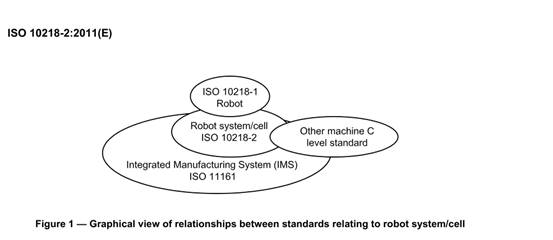ISO 10218-2:2011. Robots and robotic devices. Safety requirements for industrial robots.
Part 2: Robot systems and integration
Introduction
This part of ISO 10218 has been created in recognition of the particular hazards that are presented by industrial robot systems when integrated and installed in industrial robot cells and lines.
Hazards are frequently unique to a particular robot system The number and types of hazards are directly related to the nature of the automation process and the complexity of the installation.
The risks associated with these hazards vary with the type of robot used and its purpose and the way in which it is installed・ programmed. operated. and maintained.
For the purpose of understanding requirements in this part of ISO 10218, a word syntax is used to distinguish absolute requirements from recommended practices or suggested actions. The word 'shall* is used to identify requirements necessary for compliance with this part of ISO 10218. Such requirements have to be accomplished unless an alternative instruction is provided or a suitable alternative is determined by a risk assessment. The word *should' is used to identify suggestions .recommended actions or possible solutions for requirements. but alternatives are possible and the suggested actions are not absolute・
In recognition of the variable nature of hazards with the application of industrial robots, this part of ISO 10218 provides guidance for the assurance of safety in the integration and installation of robots. Since safety in the use of industrial robots is influenced by the design of the particular robot system, a supplementary. though
equally important, purpose is to provide guidelines for the design. construction and information for use of robot systems and cells. Requirements for the robot portion of the system can be found in ISO 10218-1.
Providing for a safe robot system or cell depends on the cooperation of a variety of “stakeholders” – those entities that share in a responsibility for the ultimate purpose of providing a safe working environment. Stakeholders may be identified as manufacturers, suppliers, integrators and users (the entity responsible for using robots), but all share the common goal of a safe (robot) machine. The requirements in this part of ISO 10218 may be assigned to one of the stakeholders, but overlapping responsibilities can involve multiple stakeholders in the same requirements. While using this part of ISO 10218. the reader is cautioned that all of the requirements identified may apply to them. even if not specifically addressed by "assigned” stakeholder tasks.
This part of ISO 10218 is complementary and in addition to ISO 10218-1, which covers the robot only. This part of ISO 10218 adds additional information in line with ISO 12100 and ISO 11161, International Standards for requirements to identify and respond in a type-C standard to unique hazards presented by the integration,
installation and requirements for use of industrial robots. New technical requirements include, but are not limited to. instructions for applying the new requirements in ISO 10218-1 for safety-related control system performance. robot stopping function, enabling device, programme verification, cableless pendant criteria, collaborating robot criteria and updated design for safety.
This part of ISO 10218 and ISO 10218-1 form part of a series of standards dealing with robots and robotic devices. Other standards cover such topics as integrated robotic systems, coordinate systems and axis motions, general characteristics, performance criteria and related testing methods, terminology, and mechanical interfaces. It is noted that these standards are interrelated and also related to other International Standards.
For ease of reading this part of ISO 1021& the words "robot” and "robot system" refer to 'industrial robot' and 'industrial robot system’ as defined in ISO 10218-1.
Figure 1 describes the relationship of the scope of machinery standards used in a robot system. The robot alone is covered by ISO 10218-1. the system and cell is covered by this part of ISO 10218. A robot cell may include other machines subject to their own C level standards, and the robot system can be part of an integrated manufacturing system covered by ISO 11161 which in turn can also make reference to other relevant B and C level standards.
